Conte II Cabinet
The Conte II Cabinet is the 66th cabinet of the Italian Republic and the second cabinet led by Giuseppe Conte.[1][2][3] The government was sworn in on 5 September 2019.[4]
| Conte II Cabinet | |
|---|---|
66th Cabinet of Italy | |
| Incumbent | |
.jpg) | |
| Date formed | 5 September 2019 |
| People and organisations | |
| Head of state | Sergio Mattarella |
| Head of government | Giuseppe Conte |
| No. of ministers | 23 (incl. Prime Minister) |
| Ministers removed | 1 resigned |
| Total no. of members | 24 |
| Member parties | M5S, PD, LeU (Art.1–SI), IV (since 18 September 2019) |
| Status in legislature | Coalition government |
| Opposition parties | Lega, FI, FdI |
| History | |
| Election(s) | 2018 election |
| Legislature term(s) | XVIII Legislature (2018–present) |
| Incoming formation | 2019 government formation |
| Predecessor | Conte I Cabinet |
| ||
|---|---|---|
Prime Minister (2018–present)
|
||
The cabinet is supported by the anti-establishment Five Star Movement (M5S) and the centre-left Democratic Party (PD), along with the leftist parliamentary group Free and Equal (LeU) and, since 17 September, the centrist party Italia Viva (IV), which splintered from the PD on that day. The government has been referred to as the "yellow-red government" (governo giallorosso), based on the customary colours of the main supporting parties.[5][6]
The Conte II Cabinet is the one with the lowest average age of its members in the history of the Italian Republic.[7]
Supporting parties
Beginning of term
At the time of the government formation, its ministers and other members were part of the following three parties.
| Party | Position | Main ideology | Leader | |
|---|---|---|---|---|
| Five Star Movement (M5S) | Big tent | Populism | Luigi Di Maio | |
| Democratic Party (PD) | Centre-left | Social democracy | Nicola Zingaretti | |
| Free and Equal (LeU)[lower-alpha 1] | Left-wing | Democratic socialism | Several leaders | |
- Political alliance between Article One (led by Roberto Speranza) and Italian Left (led by Claudio Grassi).
The government also obtained the support of the Associative Movement Italians Abroad (MAIE), and one of its senators, Ricardo Merlo, was appointed as undersecretary in the cabinet.[8] The government received also the external support of the following minor parties: Popular Civic List (CP), the Italian Socialist Party (PSI), Italy in Common (IiC), the South Tyrolean People's Party (SVP) and the Trentino Tyrolean Autonomist Party (PATT).[9][10]
Current
Currently, the government ministers and other members are from the following four parties.
| Party | Position | Main ideology | Leader | |
|---|---|---|---|---|
| Five Star Movement (M5S) | Big tent | Populism | Vito Crimi (acting) | |
| Democratic Party (PD) | Centre-left | Social democracy | Nicola Zingaretti | |
| Italia Viva (IV) | Centre | Liberalism | Matteo Renzi | |
| Free and Equal (LeU)[lower-alpha 1] | Left-wing | Democratic socialism | Several leaders | |
- Political alliance between Article One (led by Roberto Speranza) and Italian Left (led by Claudio Grassi).
On 17 September, former Prime Minister Matteo Renzi led a breakaway group outside the PD and formed Italia Viva, which confirmed its support to the government.[11]
History
Background

After the 2018 general election the Five Star Movement (M5S), which had come first in the election, and the League agreed to form a coalition government led by Giuseppe Conte, the Conte I Cabinet.
In August 2019, Matteo Salvini, Deputy Prime Minister and leader of the League, announced a motion of no confidence against the government, after growing tensions within the majority. Salvini's move came right after a vote in the Senate regarding the progress of the Turin–Lyon high-speed railway, in which the League, along with the largest opposition parties, voted against an attempt of the M5S to block the construction works.[12] Many political analysts believe the no confidence motion was an attempt to force early elections to improve his party's standing in Parliament, due to its increasing support in opinion polls, ensuring Salvini could become the next Prime Minister.[13] On 20 August, following the parliamentary debate in which Conte harshly accused Salvini of being a political opportunist who "had triggered the political crisis only to serve his personal interest",[14] the Prime Minister tendered his resignation to President Sergio Mattarella.[15]
Government formation
On 21 August, Mattarella started consultations with parliamentary groups. On the same day, the national board of the Democratic Party (PD) officially and unanimously opened to the prospect of a cabinet with the M5S,[14] based on pro-Europeanism, green economy, sustainable development, fight against economic inequality and a new immigration policy.[16] However, the talks resulted in a unclear outcome, the President announced a second round of consultations starting on 27 August.[17]
Negotiations between PD and M5S started,[18] while Free and Equal (LeU), a left-wing parliamentary group, announced its support too.[19] On 28 August, PD's leader Nicola Zingaretti announced at the Quirinal Palace his favourable position on forming a new government with the Five Stars with Conte at its head.[20] On same day, Mattarella summoned Conte to the Quirinal Palace for 29 August to give him the task of forming a new cabinet.[21] On 3 September, M5S members voted through the so-called "Rousseau Platform" in favor of an agreement with the PD, with Conte Prime Minister, with more than 79% of the vote out of nearly 80,000 voters.[22]
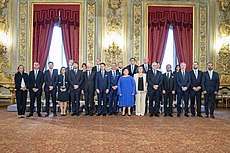
On 4 September Conte announced the ministers of this new cabinet, which was sworn in on the following day.[23] At its start, the government was composed of 21 ministers, 14 men and 7 women, a majority of whom are from Southern Italy.[24][25]
Investiture votes
On 9 September 2019 the Chamber of Deputies approved the government with 343 votes in favour, 263 against and 3 abstentions.[26][27] On the following day the Senate followed suit, with 169 in favour, 133 against and 5 abstentions.[28][29]
Investiture votes for Conte II Cabinet | |||
|---|---|---|---|
| House of Parliament | Vote | Parties | Votes |
| Chamber of Deputies (Voting: 609[lower-alpha 1] of 630, Majority: 304) |
M5S (208), PD (109), LeU (14), CP–AP–PSI–AC (4), +Eu–CD (3), Others (5) | 343 / 609 | |
| Lega (121), FI (95), FdI (33), NcI–USEI (4), Others (10) | 263 / 609 | ||
| Abstention | SVP–PATT (3) | 3 / 609 | |
| Senate of the Republic (Voting: 307[lower-alpha 2] of 321, Majority: 152) |
M5S (104), PD (49), Aut (4), LeU (4), Others (8) | 169 / 307 | |
| Lega (57), FI (56), FdI (18), +Eu (1), Others (1) | 133 / 307 | ||
| Abstention | Aut (3), M5S (1), PD (1) | 5 / 307 | |
- Absent (16): FI (4), Lega (3), M5S (3), PD (2), FdI (1), Others (3)
On institutional leave (4): M5S (4) - Absent (8): FI (5), M5S (1), Others (2)
On institutional leave (5): M5S (1), PD (1), Lega (1), Aut (1), Others (1)
President (1)
Italia Viva and M5S crises
In September 2019 former Prime Minister Matteo Renzi lead a split from the PD, and formed a party called Italia Viva. The new party had two ministers (Teresa Bellanova and Elena Bonetti) and one undersecretary, and kept its support for the Conte II government.[30]
In December 2019 the Minister of Education and Research, Lorenzo Fioramonti, resigned after disagreements with the rest of the cabinet regarding the recently approved 2020 budget bill. Fioramonti considered the share of funds dedicated to education and research to be insufficient.[31] For the designation of the new Minister, Prime Minister Conte decided to split the Ministry of Education, University and Research into two. The Ministry of Public Education went to the former undersecretary Lucia Azzolina (M5S), whereas the Ministry of University and Research went to the dean of the University of Naples Federico II, Gaetano Manfredi (Ind).[32]
In January 2020, the Five Star Movement suffered multiple parliamentary defections and a sizeable decrease in popularity with respect to the 2018 elections.[33] Luigi Di Maio resigned from his position as M5S political leader, retaining his position as foreign minister.[34]
Coronavirus outbreak
In February 2020, the COVID-19 pandemic was confirmed to have spread to northern Italian regions. In a few weeks, it spread to the rest of the country, with major concentration of cases in the regions of Lombardy, Emilia-Romagna, Piedmont and Veneto. The government faced the subsequent health crisis by imposing gradually stricter measures of social distancing and quarantine, until finally on 9 March established a nationwide lockdown, restricting the movement of people except for reasons of necessity, health, or work.[35][36]
Party breakdown
Beginning of term
Ministers
9 | |
9 | |
1 | |
3 |
Ministers and other members
- Five Star Movement (M5S): 9 ministers, 6 deputy ministers, 16 undersecretaries
- Democratic Party (PD): 9 ministers, 4 deputy ministers, 14 undersecretaries
- Free and Equal (LeU): 1 ministers, 2 undersecretaries
- Article One (Art.1): 1 minister, 1 undersecretary
- Italian Left (SI): 1 undersecretary
- Associative Movement Italians Abroad (MAIE): 1 undersecretary
- Independents: Prime minister, 2 ministers
Current
Ministers
9 | |
7 | |
2 | |
1 | |
4 |
Ministers and other members
- Five Star Movement (M5S): 9 ministers, 6 deputy ministers, 15 undersecretaries
- Democratic Party (PD): 7 ministers, 4 deputy ministers, 13 undersecretaries
- Italia Viva (IV): 2 ministers, 1 undersecretary
- Free and Equal (LeU): 1 ministers, 2 undersecretaries
- Article One (Art.1): 1 minister, 1 undersecretary
- Italian Left (SI): 1 undersecretary
- Associative Movement Italians Abroad (MAIE): 1 undersecretary
- Independents: Prime minister, 3 ministers
Geographical breakdown
Beginning of term
.svg.png)
- Northern Italy: 8 ministers
- Emilia-Romagna: 2 ministers
- Friuli-Venezia Giulia: 1 minister
- Lombardy: 2 ministers
- Piedmont: 2 ministers
- Veneto: 1 minister
- Central Italy: 2 ministers
- Lazio: 2 ministers
- Southern and Insular Italy: 12 ministers (including Conte)
- Apulia: 3 ministers (including Conte)
- Basilicata: 2 ministers
- Campania: 4 ministers
- Sicily: 3 ministers
Current
- Northern Italy: 8 ministers
- Emilia-Romagna: 2 ministers
- Friuli-Venezia Giulia: 1 minister
- Lombardy: 2 ministers
- Piedmont: 2 ministers
- Veneto: 1 minister
- Central Italy: 1 minister
- Lazio: 1 minister
- Southern and Insular Italy: 14 ministers (including Conte)
- Apulia: 3 ministers (including Conte)
- Basilicata: 2 ministers
- Campania: 5 ministers
- Sicily: 4 ministers
Council of Ministers
The Council of Ministers is composed of the following members:[37][1][2]
- Proposed by the Five Star Movement.
Composition of the Government
| Portrait | Office | Name | Term | Party | Deputy Ministers Undersecretaries | |
|---|---|---|---|---|---|---|
 |
Undersecretaries: Riccardo Fraccaro (M5S) Mario Turco (M5S) Andrea Martella (PD) | |||||
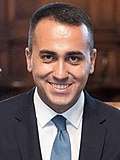 |
Deputy Ministers: Emanuela Del Re (M5S) Marina Sereni (PD) Undersecretaries: Manlio Di Stefano (M5S) Ivan Scalfarotto (IV) Ricardo Merlo (MAIE) | |||||
 |
Deputy Ministers: Vito Crimi (M5S) Matteo Mauri (PD) Undersecretaries: Carlo Sibilia (M5S) Achille Variati (PD) | |||||
 |
Undersecretaries: Vittorio Ferraresi (M5S) Andrea Giorgis (PD) | |||||
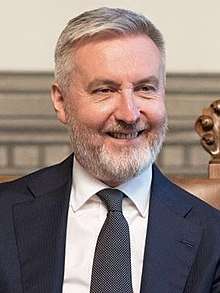 |
Undersecretaries: Angelo Tofalo (M5S) Giulio Calvisi (PD) | |||||
 |
Deputy Ministers: Laura Castelli (M5S) Antonio Misiani (PD) Undersecretaries: Alessio Villarosa (M5S) Pierpaolo Baretta (PD) Maria Cecilia Guerra (LeU/Art.1) | |||||
 |
Deputy Minister: Stefano Buffagni (M5S) Undersecretaries: Alessandra Todde (M5S) Mirella Liuzzi (M5S) Gian Paolo Manzella (PD) Alessia Morani (PD) | |||||
 |
Before 18 September 2019: Democratic Party |
Undersecretaries: Giuseppe L'Abbate (M5S) | ||||
 |
Undersecretaries: Roberto Morassut (PD) | |||||
 |
Deputy Minister: Giancarlo Cancelleri (M5S) Undersecretaries: Roberto Traversi (M5S) Salvatore Margiotta (PD) | |||||
 |
Undersecretaries: Stanislao Di Piazza (M5S) Francesca Puglisi (PD) | |||||
 |
Deputy Minister: Anna Ascani (PD) (until 10 January 2020) Undersecretaries: Lucia Azzolina (M5S) (until 10 January 2020) Giuseppe De Cristofaro (LeU/SI) (until 10 January 2020) | |||||
 |
||||||
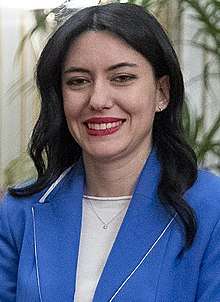 |
Deputy Minister: Anna Ascani (PD) Undersecretaries: Giuseppe De Cristofaro (LeU/SI) | |||||
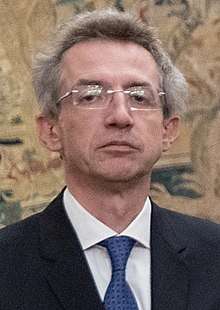 |
||||||
 |
Undersecretaries: Anna Laura Orrico (M5S) Lorenza Bonaccorsi (PD) | |||||
 |
(Article One) |
Deputy Minister: Pierpaolo Sileri (M5S) Undersecretaries: Sandra Zampa (PD) | ||||
 |
(without portfolio) |
Undersecretaries: Gianluca Castaldi (M5S) Simona Malpezzi (PD) | ||||
 |
(without portfolio) |
|||||
 |
(without portfolio) |
|||||
 |
(without portfolio) |
|||||
 |
(without portfolio) |
Before 18 September 2019: Democratic Party |
||||
.jpg) |
(without portfolio) |
Undersecretaries: Laura Agea (M5S) | ||||
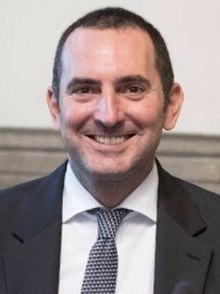 |
(without portfolio) |
|||||
 |
(without portfolio) |
|||||
 |
— | |||||
- On 28 December 2019, after the resignation of former Minister of Education, University and Research, Lorenzo Fioramonti, the prime minister split the Ministry into a Ministry of Public Education and a Ministry of University and Research.
- Fioramonti resigned after disagreements on the 2020 financial budget bill. According to Fioramonti, the approved bill allocated insufficient funds for education and research.
References
- "Here is Italy's new cabinet in full". www.thelocal.it. 4 September 2019. Retrieved 7 September 2019.
- Barigazzi, Jacopo (4 September 2019). "Italy's Conte presents Cabinet list, with MEP Gualtieri as finance minister". POLITICO. Retrieved 7 September 2019.
- "Governo Conte bis: ecco la lista completa dei ministri". Repubblica.it. 4 September 2019.
- "Conte Bis, lunedì alle 11 dibattito fiducia alla Camera". Adnkronos (in Italian). Retrieved 4 September 2019.
- Johnson, Miles (4 September 2019). "Giuseppe Conte seeks go-ahead to form Italy coalition government". Financial Times. Rome. Retrieved 26 October 2019.
- "Governo giallo-rosso e l'interesse nazionale". L'HuffPost. 31 August 2019.
- "Governo Conte 2, è un esecutivo di 40enni: il più giovane della storia repubblicana. Per Di Maio record alla Farnesina". Il Fatto Quotidiano. 4 September 2019.
- Riccardo Merlo (MAIE) confermato sottosegretario agli steri
- La Camera vota la fiducia con 343 sì, il premier replica alla Camera fra le proteste. Alzata anche una sedia
- Governo, il Conte bis incassa la fiducia alla Camera. Il discorso del premier
- Amante, Angelo; Ciociola, Andrea (17 September 2019). "Former Italy PM Renzi leads breakaway from PD, still backs government". Reuters. Retrieved 18 September 2019.
- https://www.corriere.it/politica/19_agosto_07/voto-tav-giorno-mozioni-senato-lega-vota-quella-pd-5d7ba448-b8e6-11e9-8028-c32e9be56d04.shtml
- Squires, Nick (9 August 2019). "Italy's League files no confidence motion in prime minister in bid to trigger election". The Telegraph – via www.telegraph.co.uk.
- Giuffrida, Angela (20 August 2019). "Italian PM resigns with attack on 'opportunist' Salvini". The Guardian – via www.theguardian.com.
- Horowitz, Jason (20 August 2019). "Italy's Government Collapses, Turning Chaos Into Crisis". The New York Times.
- "Governo, Zingaretti: "I 5 punti per trattare con il M5S. No accordicchi, governo di svolta"". Repubblica.it. 21 August 2019.
- "Crisi di governo, secondo giro di consultazioni al Colle". Tgcom24.
- "Ecco l'accordo sul Conte bis: Zingaretti dà il via libera, nodo su ministeri e manovra". Fanpage.
- "Grasso, possibile intesa M5s-Pd-Leu - Ultima Ora". Agenzia ANSA. 19 August 2019.
- "Italy's Conte might be back at helm with Salvini shut out". Washington Post.
- "C'è l'accordo tra M5s e Pd. Governo giallorosso ai nastri di partenza". Agi.
- "Governo, via libera di Rousseau all'intesa M5s-Pd con il 79% dei voti. Conte domattina al Quirinale". Repubblica.it. 3 September 2019.
- "Governo, Conte e i ministri hanno giurato. Gentiloni in pole per successione a Moscovici". Repubblica.it. 5 September 2019.
- "Governo, i 21 ministri del Conte bis Sette donne, Lamorgese all'Interno". www.ilgazzettino.it.
- "Governo, 11 ministri dal Sud: 4 sono campani". Repubblica.it. 4 September 2019.
- D'Emilio, Frances (9 September 2019). "Italy's Conte wins first confidence vote in Parliament". AP NEWS. Retrieved 12 September 2019.
- "Resoconto stenografico dell'Assemblea Seduta n. 222 di lunedì 9 settembre 2019". camera.it (in Italian). Camera dei Deputati. Retrieved 10 September 2019.
- Zampano, Giada (10 September 2019). "Italy's new pro-EU govt wins vote, now faces 2020 budget". AP NEWS. Retrieved 12 September 2019.
- "Legislatura 18ª - Aula - Resoconto stenografico della seduta n. 148 del 10/09/2019". senato.it (in Italian). 10 September 2019. Retrieved 12 September 2019.
- Amante, Angelo; Ciociola, Andrea (17 September 2019). "Former Italy PM Renzi leads breakaway from PD, still backs government". Reuters. Retrieved 26 December 2019.
- Jones, Gavin (25 December 2019). "Italy education minister resigns over lack of funds for ministry". Reuters. Retrieved 26 December 2019.
- "Conte:: "Separare la Scuola dall'Università. Azzolina ministro dell'Istruzione e Manfredi della Ricerca"". Repubblica.it (in Italian). 28 December 2019. Retrieved 28 December 2019.
- Horowitz, Jason (18 January 2020). "As Five Star Party Risks Implosion, Italy Fears the Fallout". The New York Times. Retrieved 24 January 2020.
- Giuffrida, Angela (22 January 2020). "Luigi Di Maio resigns as leader of Italy's Five Star Movement". The Guardian. Retrieved 24 January 2020.
- Sciorilli Borrelli, Silvia (9 March 2020). "Italy orders total lockdown over coronavirus". POLITICO. Retrieved 17 March 2020.
- Di Donato, Valentina; Reynolds, Emma; Picheta, Rob (13 March 2020). "All of Italy is in lockdown as coronavirus cases rise". CNN. Retrieved 17 March 2020.
- "Governo Conte II". www.governo.it (in Italian). 4 September 2019. Retrieved 7 September 2019.
.jpg)
